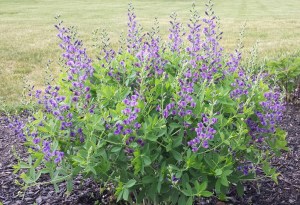Almost six years ago, I transformed the front bed of my parent’s house using Baptisia as the anchor because honestly, it blew me away when I saw it at their local nursery. The color of the blooms drew my eye in as soon as we set foot on the nursery grounds. Score one for the marketing department. No research for preferred conditions necessary, we liked it and we were going to plant it.
Fast forward three years and the Baptisia went bananas. My father did his best to control it but the end result was it was moved from its original spot because it was threatening to eat all of the other plants. Strike one against the son who claimed to be a gardening expert. Remember kiddies, always take into account a plant’s ultimate size when planning your garden. Don’t follow the lead of Uncle Johnnie.
Fast forward another year and it’s time for me to add Baptisia to my own garden. Space wouldn’t be an issue and I needed to prove to myself that I could grow it successfully. On top of that I could no longer take all of the stunning photos of this perennial in others’ gardens without giving it a shot myself. From all indications, Baptisia preferred a more dry soil and it was debatable whether or not it was deer resistant but I didn’t care. It was time to throw caution to the wind, wet soil and herds of deer be damned.
Fast forward to 2015 and John is a happy boy.
Two years in the ground and it was already kicking ass. Those blooms draw in the eye and put a smile on my face each and every morning as I walked out to my car on my way to work. The deer left it alone and as of current day, the poorly draining soil doesn’t appear to be an issue.
Some additional Baptisia australis (Blue False Indigo) info:
- Native to the eastern U.S
- Blooms from May to June
- The pea-like blooms are a blue/purple
- Speaking of peas, Baptisia is part of the pea family, Fabaceae
- Survives in zones 3-9
- Mature size is roughly 4 x 4
- Prefers full sun as it tends to open up with more shade (my parent’s garden as scientific proof).
- Deer resistance is questionable but I’ve had no issues the first two years.
- Can be slow to establish but once it is, it is a bear to move due to its deep taproot.
- Can handle all soil types and it drought tolerant once established.
- Baptisia comes from the greek word “bapto” which means dye. It was used back in the day as a blue dye replacement for Blue Indigo.
- Tough to divide due to the taproot and it can be slow to establish if grown by seed.
- Baptisia australis opens up a bit after bloom and if the plant is cut back at that time, it will result in a more upright and appealing shape. The downside is the ornamental seedpods will be lost (more on that in a moment).
And now a little chronological tour of this shrub-like perennial:
First emerging in spring.
Then the first signs of bloom appear.
Almost there.
In full bloom.
And once in bloom, drawing in the critters.
By the time fall/winter has arrived, the ripened seed heads have turned black, eventually opening up to reveal the seeds inside.
And finally the opened seed heads still adorning Baptisia australis in late winter.



















I have trouble growing Lupine and to flower. So my substitute has been Baptisia for reliability and resembles
somewhat the Lupine flowers. That works for me!
i think you would love Camassia if you’re into this heavenly blue! Flowers earlier and could be a great complement!